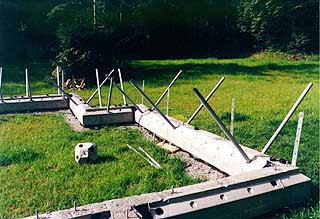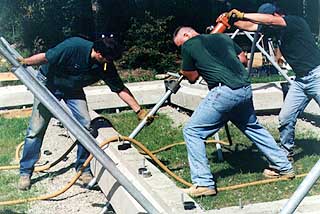
Surveys
DJC.COM
July 12, 2001
New Pin Foundation minimizes site impacts
Special to the Journal

A typical Pin Foundation ready for installation shows pins before they are driven several feet into the ground to provide a stable building base without disturbing the soil with excavating. |
There’s more than one way to make a house foundation, Rick Gagliano discovered when he created and patented an approach that particularly appeals to “green builders” who want to protect and preserve a site’s environment.
Why does a foundation always have to involve excavation, loss of top soil, erosion prevention measures, drainage control and extra work, he asked himself several years ago. Now the Gig Harbor man’s business, Pin Foundations Inc., offers foundations without excavation.
With salmon stream protection now a significant issue in construction work, Gagliano’s technique is attracting some attention.
“The timing is right. We’re in a very good position. Unlike other new ideas or products responding to current environmental issues, we’ve gone through our testing and approval process and we’re ready to install our product,” Gagliano said. “We’ve taken a lead here that no one else has. Instead of creating problems on a construction site, we figure how to not create a problem in the first place.”

Photos courtesy of Pin Foundations A crew of workers drives steel pins through channels in concrete segments of a Pin Foundation to secure it to the ground without disturbing the soil. |
Installing a pin foundation is far different than the normal process of grading a home site and excavating for a foundation. Pin Foundation’s FootPrint system involves pouring concrete into custom-designed forms that create a home’s foundation, then driving 5-to-9-foot-long steel pins diagonally through both sides of the concrete to anchor it securely to the ground.
The concept is that simple. The engineering is much tougher. An architect by training, Gagliano once had his own design-build business in New York. A couple of boardwalk projects built on poor soil on Long Island became the seeds for later ideas when he was completing graduate work at the University of California at Berkeley, ideas that culminated in creating pin-fastened foundations.
“The advantage of our foundation system is that the original soil is preserved without being disturbed, so historic storm water flows are also preserved, eliminating erosion and other run-off problems common to construction sites. For decades, foundation construction has involved removing the top layer of soil, which takes away the natural ability of that soil to store and filter run-off water. Efforts to replace that soil once it’s been stripped away just have not measured up. Today’s emphasis on protecting salmon under the Endangered Species Act means it’s important locally and nationally to be able to provide low-impact development techniques.”
So far, Gagliano’s system has seen only limited use in the housing industry, primarily because it is so new and innovative that it doesn’t meet building codes. To overcome that barrier, he has worked closely with Pierce County building department officials for the past six years, developing a system that is individually designed for each structure’s size and weight so foundation plans submitted with an engineer’s stamp are accepted for permitting.
In 1995, he built a two-car garage for himself on a pin foundation and tested it for three years, measuring a settling of only one-quarter of an inch. In 1998, he refined the system and built a two-story, 2,300-square-foot home on a pin foundation. He estimated the foundation cost about 10 percent more than a conventional one, after allowing for his savings from usual excavation, backfill and drainage system costs. The pin foundation also uses 40 percent less concrete than conventional foundations, Gagliano said.
Since then, the cost of a pin foundation – about $30 - $35 per linear foot – has declined with refinements. Even greater savings are expected from sites that are more complicated than the level ground he built on, since the cost of conventional systems rises faster than the incremental costs of the company’s FootPrint pin foundation as projects become more complex.
Gagliano believes his pin foundations have a place in the building of conventional subdivisions, too, not just for single projects or custom homes.
“Large builders of neighborhood-size plats have the potential to save a lot of indirect costs in the ways they grade the property, reducing or eliminating compaction and erosion control costs and even downsizing retention ponds,” he said. “For a 30-to-50-home development there are still roadway and sidewalk surfaces that cause stormwater runoff problems, but if a retention pond can be downsized 15 to 25 percent, that’s a big advantage to developers.”
So how is such a revolutionary approach to foundations marketed in the industry?.
| How a Pin Foundation works |
|
The patented Pin Foundation FootPrint system uses a steel-reinforced perimeter grade beam, poured in reusable concrete forms resting on a gravel bedding or pre-cast in concrete. First, soil and site characteristics must be determined since pin foundations are pre-engineered systems. Pin Foundations will provide assistance with designing structures and site orientation, as well as advising on framing layouts that make the most effective use of the systems. Since existing vegetation remains in place during the entire construction process, soil continues to absorb and process rain water as it always has, plus the building site is cleaner than excavated sites. Once the beams are in place, a jackhammer drives heavy steel pins through angled channels to depths of 5 to 9 feet, depending on either hard or soft soil conditions. The pins criss-cross from opposite sides of the beams to provide a stable foundation. The number of pins is determined by the weight of the building and the soil profile. A mud sill is bolted to the grade beam. The FootPrint system easily follows a home’s irregular plan outline and accepts the region’s required earthquake strapping. When the beams follow a sloping grade, the crawl space cripple wall is framed at an angle to provide a level flow. Once the foundation is pinned down, construction of the structure proceeds as it would on any conventional building site. |
“Changing an industry standard is not an easy task,” Gagliano admits. “Some developers see standard permitted foundations as an acceptable way of building and don’t want to change, but regulators are wrestling with environmental issues now that will force change. But in green building as a whole a lot of those developers are accepting new ways of building because they’re trying to re-think how things are built. This is one of the first steps.”
While he’s run a few advertisements in green building publications, most of his promotion time is spent presenting his concepts to architects, builders and civil engineers at conferences or symposiums rather than trade shows. Early this year, he was a participant in Seattle’s NAHB-sponsored Green Building conference and a few weeks ago he presented his pin foundation technology to the Low Impact Development 2001 conference in Seattle, attended by nearly 400 civil engineers, building officials, storm water management engineers, designers and developers from all over the country.
Although Gagliano’s pin foundations are just entering the marketplace, now that they’ve established standards in Pierce County that can be shown to other jurisdictions, he is hoping business will grow.
Because excavation for pier foundations and footings usually results in significant soil impact it has become a major issue in areas such as the Pacific Northwest. So Gagliano has patented a “Diamond” pier support of precast concrete that is pinned in place by two to four angled-pins, depending on the type of soil. The pier support is set in a shallow hole and the driven pins are capped. The bottom half of the pier is pointed, allowing for movement or expansion of frost-area soils.
The company’s “butterfly” bracket is an all-steel support system fastened to the ground with pins, used primarily for residential decks and walkways with relatively light loads, designed to work with 4x4 posts. The company’s Speed Pile is a versatile bracket bolted into post or grade beam timber and then pinned on either side for securing to the ground.
Most of the company’s pier and post foundation products have been used in parks, wildlife areas and environments where it’s important to have minimal disturbance of the soil. Typical installations have been made at the Narbeck wetlands boardwalk near the Everett Boeing aircraft plant; the Nisqually Interpretive Trail near Tacoma and sensitive-area walkways in state and national parks across the country.
For more information, contact Rick Gagliano at 8607 58th Ave. N.W., Gig Harbor 98332, or call (253) 858-8809, or visit his Web site at www.pinfoundations.com.
Terry Stephens is a freelance writer based in Arlington. He can be reached by e-mail at features@gte.net.
Other Stories:
- Pesticide-free parks teach new lessons
- Construction faces new foe: toxic mold
- Water metering: the debate trickles on
- Studies sniff out Tacoma smelter plume
- Tree investment brings cities many happy returns
- From wood preservation to site remediation — the Cascade Pole cleanup
- New rules for birds, bogs and bulldozers
- Isolated wetlands ruling creates confusion
- Environmental metamorphosis on the Duwamish
- Mitigation banks balance habitat, development
- Bringing a city stream back to life
- Knitting a trail of green
- Stormwater problems? Put a LID on it
- More brownfield incentives in the pipeline
- SEPA document trends since GMA and regulatory reform
- Helping environmental groups to get wired
- Shedding light into the permit ‘black hole’
- Frequently asked ESA questions
- Muddy waters: The new 4(d) salmon rule
- Global climate change starts at home
- At EPA, next 4 years won’t be boring
- Dams vs. fish? Mediate it!
- 'House calls' help firms to conserve
- Building a greener future on Bainbridge
- Power users, producers turn toward the sun
- Seattle goes climate neutral
- Bamboo’s popularity shoots up
- Tiny town recycles Goliath proportions
- MTCA revisions take effect Aug. 15
- Environmental education: Knowing what’s in your backyard
- Bear Creek roars again
- UW Bothell — a wetland lesson in the making
Copyright ©2009 Seattle Daily Journal and DJC.COM.
Comments? Questions? Contact us.